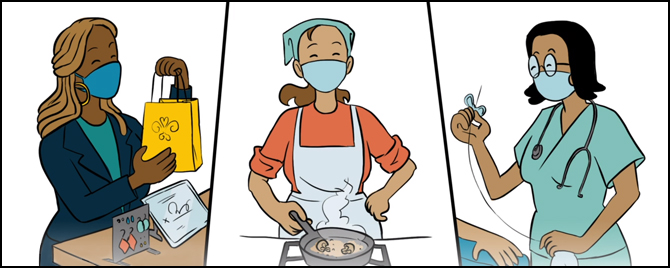Mothers from low-to-moderate income families of color dropped out of the workforce more than others during the pandemic. As the economy recovers, what changes will be most effective to help these mothers return to work? Our animated Economic Letter explores this question.
Many mothers, especially from lower income families of color, dropped out of the labor force at the start of the 2020 school year. Watch our short video for changes that will help mothers rejoin the work force. (video, 1:23 minutes).
Transcript
[Image: Two people in winter clothing are walking on opposite sides of a street. There is snow on the ground, and in the background are three storefronts and two trees without leaves.]
After the massive loss of U.S. jobs at the start of the pandemic, men and women began returning to work in the summer of 2020.
[Image: A man in short sleeves with a dog crosses the street. A woman wearing a dress and a man wearing a tank top wave as they pass each other on the sidewalk. Someone skateboards down the street. Everyone is wearing a mask. In the background there are three storefronts, two trees with green leaves, and red flowers next to the trees.]
People continued to rejoin the workforce through the fall months, except for one group.
[Image: Server takes order from a couple in outdoor dining area. A construction worker climbs a ladder and drills into awning above a storefront. A woman talking on her phone crosses the street.]
With the start of the new school year still disrupted by the pandemic, many mothers with children at home dropped out of the labor force again, reflecting that mothers took on the burden of schooling children.
[Image: A mother with a worried look on her face looks out the window while holding a child in her arms. Her other child also looks out the window while holding back a curtain. Image transitions to the same mother typing on a laptop, while one child yanks at the back of her shirt and another child wearing headphones points at the laptop.]
This hit mothers with the lowest family incomes—those earning less than $50,000 a year—the hardest. Nearly 9% of mothers in this group dropped out of the job market between February and December 2020.
[Image: An anxious mother sits on a bed and looks over her two sleeping children. Image transitions to children’s toys interspersed with three pages torn out of a calendar: FEB 1, AUG 17, DEC 28.]
Among the most severely affected were Black and Hispanic mothers. They dropped out of the labor force at nearly twice the rate of white mothers.
[Image: A mother and her two children eat at a table together. A mother looks through a window while holding her infant.]
As the economy recovers, what changes will be most effective to help these mothers return to the workforce?
[Image: Three determined women look straight ahead.]
Mothers benefited more from flexible work schedules than from telework during the pandemic. This allowed them to better balance paid work and home life.
[Image: Three women at their jobs: one is preparing a purchase at a jewelry store, one is cooking food over a stove, and one is working with a patient in a doctor’s office.]
Meeting the need for flexibility can help mothers return to the workforce, which is important for ensuring the economy benefits everyone.
Learn more at https://sffed.us/mothers
You may also be interested in:
- Mothers in a Pandemic Labor Market
- $3 Trillion a Year and Growing: Potential Economic Gains from Equity
- How Much Did the CARES Act Help Households Stay Afloat?
- “From Gaps to Growth: Equity as a Path to Prosperity”, a speech by SF Fed President Daly
- Key Event Takeaways: Harnessing the American Rescue Plan Act to Support Innovation in Child Care
- Investing in the Future of Child Care: Child Care as a Community Investment
The views expressed here do not necessarily reflect the views of the management of the Federal Reserve Bank of San Francisco or of the Board of Governors of the Federal Reserve System.
